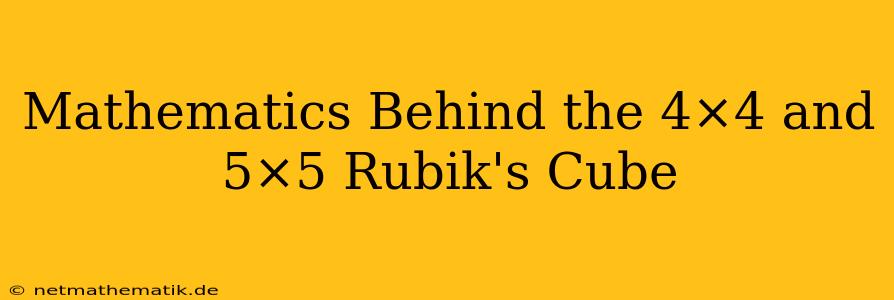The Rubik's Cube, a seemingly simple toy with colorful squares, holds within it a fascinating world of mathematical complexity. The iconic 3x3 cube, with its six faces and intricate mechanisms, has captured the minds of puzzle enthusiasts for decades. But delve deeper, and you'll find that the seemingly complex 4x4 and 5x5 Rubik's Cubes, with their increased number of pieces and layers, are not simply larger versions of their 3x3 counterpart. They introduce a new level of mathematical challenge, requiring a different approach and understanding to master. This article explores the mathematics behind the 4x4 and 5x5 Rubik's Cubes, unveiling the hidden patterns and algorithms that govern their rotations and solutions.
The Fundamentals of Cube Structure
Understanding the mathematics behind the 4x4 and 5x5 Rubik's Cubes begins with grasping the basic structure of any cube. Each face of a cube is a square, and the entire cube is made up of smaller cubes called "cubies." The 3x3 cube features corner cubies, edge cubies, and center cubies. The 4x4 and 5x5 cubes add another layer of complexity with the introduction of "inner" cubies. These are the cubies that sit between the edge and center cubies, and they play a critical role in solving the puzzle.
The Importance of Permutations and Group Theory
The core mathematical concept behind solving any Rubik's Cube is permutation. A permutation is a way of arranging objects in a specific order. In the context of the cube, a permutation refers to the rearrangement of the cubies when you perform a twist. To understand this concept, let's consider the 3x3 cube. Each face has 9 cubies, and there are 6 faces. This gives us a total of 54 cubies. However, not all of these cubies can be freely swapped. The center cubies are fixed, leaving us with 48 cubies that can be permuted.
The Complexity of Higher-Order Cubes
The 4x4 and 5x5 cubes introduce significant complexity. The 4x4 cube has 16 center cubies, 8 edge cubies, and 24 corner cubies. A key difference from the 3x3 is the addition of 24 inner cubies. These inner cubies can be permuted, adding another dimension to the puzzle's complexity. The 5x5 cube continues this trend, with even more inner cubies and a greater number of potential permutations.
Exploring the Mathematics of the 4x4 and 5x5 Cubes
Parity: The Oddity of Even Permutations
One of the most intriguing mathematical concepts that emerges with the 4x4 and 5x5 cubes is the concept of parity. In simpler terms, parity refers to whether a permutation is even or odd. An even permutation can be achieved by an even number of swaps, while an odd permutation requires an odd number of swaps.
Parity in the 4x4 and 5x5 Cubes: In the 4x4 and 5x5 cubes, the parity of the permutations of corner and edge cubies is crucial. If the parity of the corner and edge cubies is different (one is even, the other odd), the cube cannot be solved. This concept arises due to the inner cubies, which act as invisible "parity" indicators. They can be used to correct the parity of the corner and edge cubies, allowing the cube to be solved.
Algorithms and Commutators
Solving any Rubik's Cube involves a series of specific rotations, called "algorithms." Algorithms are essentially sequences of moves that manipulate the cubies to achieve a desired state. For instance, a simple algorithm might be "R U R' U'" (where R is a right-side rotation, U is an up-side rotation, and ' denotes a counter-clockwise rotation).
The 4x4 and 5x5 cubes require more complex algorithms than the 3x3, as they have additional layers and inner cubies. The 4x4 cube, for example, features algorithms that address the parity issue. These algorithms, often involving specific "commutators" (sequences of moves that "undo" each other) can be used to correct the parity of the corner and edge cubies.
The Power of Commutators
Commutators play a crucial role in solving both the 4x4 and 5x5 cubes. A commutator is a sequence of moves that is followed by the reverse of that sequence, effectively "undoing" the initial moves. For example, a basic commutator might be "[R U R' U']".
Commutators in the 4x4 and 5x5 Cubes: Commutators are particularly useful in addressing the inner cubies. By performing a commutator on the inner cubies, you can manipulate them without affecting the outer layers of the cube. This allows for targeted moves and efficient solving strategies.
Mastering the Challenges of Higher-Order Cubes
The 4x4 and 5x5 Rubik's Cubes, while more complex, present unique challenges and rewards. They require a deeper understanding of permutation, parity, and algorithms. The concept of "commutators" becomes essential in maneuvering the inner cubies and achieving a solved state. However, the satisfaction of solving these higher-order cubes is immense.
Conclusion
The 4x4 and 5x5 Rubik's Cubes are more than just bigger versions of their 3x3 counterpart. They represent a fascinating mathematical journey, challenging our understanding of permutations, parity, and algorithms. The intricacies of these cubes reveal the power of mathematical principles in solving complex problems, reminding us that even in a simple toy, there lies a world of hidden mathematical beauty and intrigue. As you explore the intricacies of the 4x4 and 5x5 Rubik's Cubes, remember that each twist and turn is a step towards a deeper understanding of the mathematics behind the 4x4 and 5x5 Rubik's Cube.
